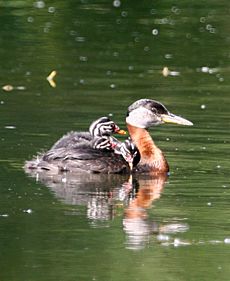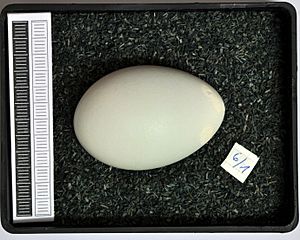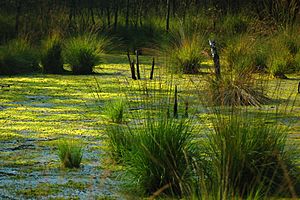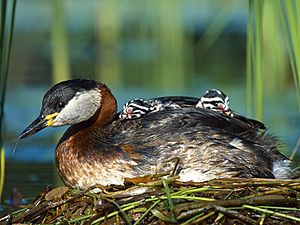Red-necked grebe facts for kids
Quick facts for kids Red-necked grebe |
|
|---|---|
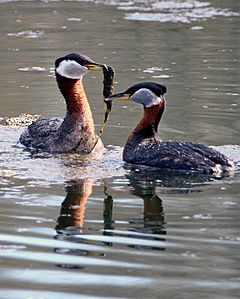 |
|
| Gifts of aquatic plants are part of the courtship display | |
| Conservation status | |
| Scientific classification | |
| Kingdom: | |
| Phylum: | |
| Class: | |
| Order: | |
| Family: | |
| Genus: |
Podiceps
|
| Species: |
P. grisegena
|
| Binomial name | |
| Podiceps grisegena (Boddaert, 1783)
|
|
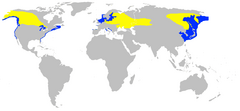 |
|
| Range of P. grisegena Breeding range Wintering range | |
| Synonyms | |
|
Podiceps griseigena (Lapsus) |
|
The red-necked grebe (Podiceps grisegena) is a migratory water bird that lives in the northern parts of the world. It likes places with mild weather. In winter, it mostly stays in calm ocean waters near the coast, but some grebes also spend winter on big lakes. For breeding, grebes like shallow fresh water, such as lakes, marshes, or fish ponds.
In winter, the red-necked grebe looks dull, with dusky-grey feathers. When it's time to breed, it gets its bright red neck, black cap, and pale grey face. These colors give it its name. It also has a special courtship dance and makes loud calls to find a mate. Once a pair forms, they build a nest from water plants. The nest floats on top of plants in a shallow lake or bog.
Like all grebes, the red-necked grebe is a great swimmer and a very fast diver. When it feels danger, it dives underwater instead of flying away. Its feet are placed far back on its body, near its tail. This makes it clumsy on land. It dives to catch fish or picks insects off plants. It also swallows its own feathers. Scientists think this might help protect its stomach. There are two types of red-necked grebes. One lives in Europe and western Asia, and the other, which is larger, lives in North America and eastern Siberia. Both types are considered to be of "Least Concern" for their survival. Their numbers are stable or growing.
Contents
About the Red-necked Grebe
What is a Grebe?
Grebes are small to medium-sized water birds. They have toes that are lobed, not fully webbed like a duck's foot. The most common group of grebes is called Podiceps. This group has nine species, but one has recently become extinct. The red-necked grebe's closest relative is the great crested grebe, which eats fish and lives in Europe and western Asia.
Scientists think the red-necked grebe might have first lived in North America. Then, it spread to Europe. There, it started eating more insects. This helped it avoid competing for food with its larger cousin, the great crested grebe. Fossils of this bird have been found in Italy. They are from the middle Pleistocene era, which was a very long time ago.
Types of Red-necked Grebes
The red-necked grebe has two main types, called subspecies:
- P. g. grisegena: This type lives in Europe and western Asia.
- P. g. holboelii: This type is also called Holboell's grebe. It lives in North America and eastern Siberia. It was named after a Danish explorer of Greenlandic birds, Carl Peter Holbøll.
Birds from eastern Asia have slightly smaller bills than those in America. However, the differences are too small to make them a third subspecies.
Physical Features of the Red-necked Grebe
The red-necked grebe is a medium-sized grebe. It is smaller than the great crested grebe found in Europe and Asia. It is also smaller than the western and Clark's grebes in North America.
Size and Appearance
An adult European red-necked grebe is about 40 to 50 centimeters (16 to 20 inches) long. Its wingspan is usually 77 to 85 centimeters (30 to 33 inches). It weighs about 692 to 925 grams (1.5 to 2 pounds).
When it's breeding season, the bird has:
- A black cap that goes below its eye.
- Very pale grey cheeks and throat.
- A rusty red neck.
- Dark grey back and sides.
- White belly.
- Dark brown eyes.
- A long, pointed black bill with a yellow base.
In winter, the red-necked grebe looks duller. Its dark grey cap is not as clear and blends into its grey face. A pale curve behind its face stands out against the rest of its head. The front of its neck is whitish or light grey, and the back of its neck is darker grey. The yellow on its bill is less noticeable than in summer.
While it's easy to spot in breeding plumage, it can be harder to tell apart in winter. It is larger than the Slavonian (horned) grebe. It also has a bigger bill and a grey face, not white. It's similar in size to the great crested grebe. However, that bird has a longer neck, a more striking head pattern, and always has white above its eye.
Male and female grebes look similar. However, males are usually heavier than females. Young chicks have striped heads and chests. Older young birds have striped faces, a faint blackish cap, a pale red neck, and a lot of yellow on their bills.
The American subspecies (P. g. holboelii) is larger. It is 43 to 56 centimeters (17 to 22 inches) long. Its wingspan is 61 to 88 centimeters (24 to 35 inches). It weighs 750 to 1600 grams (1.6 to 3.5 pounds). Its feathers look the same as the European type. However, the adult's bill has more yellow. The size difference between male and female is greater in this subspecies.
How They Move
The red-necked grebe flies with its long neck stretched out and its large feet trailing behind. This makes it look very long. Its small wings are grey with white secondary feathers. They beat very fast. Because its wings are small, the grebe cannot take off from land. It needs a long run across water to get enough speed to fly. Like all grebes, the red-necked grebe is an expert swimmer. It uses its feet to push itself underwater. It steers by turning its legs, because its tail is too short to help.
Sounds They Make
This grebe is one of the most vocal grebes during the breeding season. But, like its relatives, it is mostly quiet for the rest of the year. It has a loud, wailing or howling call that sounds like uooooh. A single bird or a pair can make this call, day or night, often from hidden spots. During fights between rival birds, they might make up to 60 calls in a row. They also make many other sounds like quacking, clucking, hissing, rattling, and purring. Each bird's calls can sound a bit different.
Where Red-necked Grebes Live
Red-necked grebes breed in shallow freshwater lakes, bays of larger lakes, marshes, and other inland waters. These places are often small, less than 3 hectares (7.4 acres), and shallow, less than 2 meters (6.6 feet) deep. The red-necked grebe prefers waters in forested areas. Further north, they like shrub tundra. They favor spots with lots of plants growing out of the water, like reedbeds. The best breeding places are fish ponds. These ponds have plenty of food and meet all their other needs. The American subspecies is less dependent on many water plants. It sometimes breeds on quite open lakes.
All red-necked grebes migrate. They spend winter mostly at sea, usually in river mouths and bays. They often go far offshore where fish are easy to catch near shallow banks or islands. In winter, they prefer water less than 15 meters (49 feet) deep with a sandy or gravel bottom. This habitat often has scattered rocks and patches of seaweed. During winter, birds usually feed alone and rarely gather in large groups. However, during migration, more than 2000 birds might gather at favorite resting spots.
Migration usually happens at night. But it can also happen during the day, especially over water. This is very clear in autumn on the Great Lakes. Up to 18,000 birds might pass Whitefish Point on Lake Superior. These birds are thought to be Canadian breeders heading to the Atlantic Ocean for winter. This eastern route is longer than going to the Pacific, but it avoids the Rocky Mountains.
The red-necked grebe's breeding range overlaps with the Slavonian grebe. However, the Slavonian grebe tends to be pushed out of places that suit both species. The red-necked grebe likes an inland climate with mild temperatures. It does not do as well near coasts or in very cold or very warm areas. It is usually a bird of lowlands, breeding below 100 meters (330 feet). But it has nested as high as 1800 meters (5900 feet) in Turkey.
The European subspecies breeds from southern Sweden and Denmark, across central and eastern Europe, east to western Siberia. It winters mainly in the North and Baltic Seas. Smaller numbers winter in the Adriatic, Black Sea, Caspian Sea, Mediterranean, and on inland lakes.
The American subspecies (P. g. holboelii) breeds in North America in Alaska, western and central Canada, and the northern US east to Minnesota. In Asia, it nests in eastern Siberia from Kamchatka south to Hokkaido and west to Mongolia. The Asian birds winter at sea from Japan to the East China Sea. American breeders winter in the Pacific, mostly from southern Alaska to British Columbia (with smaller numbers south to California). They also winter in the Atlantic from Newfoundland and Labrador to Florida. Some birds stay on the Great Lakes if the water does not freeze too much. This species is rarely seen in winter in Afghanistan, Pakistan, and parts of northern and western India.
Red-necked Grebe Life Cycle and Behavior
Breeding and Raising Young
Red-necked grebes usually nest alone. Their nests are often more than 50 meters (160 feet) apart. However, they might nest in small groups in good spots. Up to 20 pairs might each defend a small area. Group nesting is more likely in prime locations. These are often large floating mats of plants not connected to the shore. Such spots are safe from most predators and offer protection from wind and waves. In these places, grebes nest much closer, sometimes as close as 10 meters (33 feet). Pairs nesting in these groups lay more eggs. Their eggs hatch earlier, and they raise more chicks.
The grebes defend their nesting area with different threat displays. These include spreading their wings, hunching their bodies, and thrusting their bills. Pairs that nest in groups are more aggressive. They are less likely to leave their nest unguarded. They also tend to move out of sight of the group when they are not sitting on their eggs. They often breed near gulls or other water birds that nest in groups.
A male and female grebe form a pair in April or May. This can happen during migration or at the breeding water. Then, a very loud courtship ritual begins. Their special breeding dance includes shaking heads, a low "cat" display, and rushing side-by-side while standing upright. They also give each other green weeds. The dance ends with a "penguin" dance. In this dance, both birds stand upright, chest to chest.
Like all grebes, the red-necked grebe builds its nest near water. This allows it to escape quickly, as its legs are too far back on its body for fast movement on land. It often nests deeper inside reed beds than other grebes. The nest is a floating platform made of plant material. It is tied to plants that are underwater or sticking out of the water. The nest is in water about 0.5 to 0.75 meters (1.6 to 2.5 feet) deep. Most of the nest is below the water line.
Egg-laying mostly happens from mid-April to May in Europe. In North America, it's a bit later, from mid-May to June. Parents might leave the nest for long periods during the night. This might be to avoid predators that hunt at night. It's not clear if this is for their own safety or to protect the eggs by drawing attention away from the nest. The eggs do not seem to be harmed by this temporary leaving.
The red-necked grebe usually lays four or five dull white or pale blue eggs. Sometimes it lays one to nine eggs. Each egg is about 3.4 centimeters (1.3 inches) wide and 5.1 centimeters (2 inches) long. They weigh about 30.5 grams (1.1 ounces), with 10% of that being the shell. Both parents take turns sitting on the eggs for 21 to 33 days. When the fluffy chicks hatch, they immediately climb onto a parent's back. They stay there most of the time until they are 10 to 17 days old. The parents may feed the young for up to 54 days after they learn to fly. The young can fly when they are 50 to 70 days old.
The parents do not stop feeding their chicks when they are still being carried. Later, they take care of the younger chicks for longer and are more strict with the older ones. This helps all chicks survive equally after they learn to fly. It also encourages them to become independent. The parents might split the brood. This means each parent feeds only some of the chicks. This shares the feeding work equally between the parents.
After breeding, the adults lose their wing feathers and cannot fly for a while. This is called molting. They start migrating once their flight feathers grow back. Red-necked grebes usually have only one group of chicks per year. However, they might have a second group or re-nest if their first eggs are lost. This can extend nesting into July or August.
Eggs can be destroyed and chicks killed by predators. These include the raccoon in North America and the carrion crow in Europe. Large fish like pike might catch swimming chicks. On average, for every adult, about 0.65 young birds are still alive by their fourth month. The death rate for adult birds is not known. Red-necked grebes try to escape birds of prey by diving. When they are feeding, their dives last less than 30 seconds. But escape dives are longer.
What Red-necked Grebes Eat
In their breeding areas, red-necked grebes mainly eat invertebrates. These include adult and young aquatic insects, like water beetles and dragonfly larvae. They also eat crayfish and molluscs. Fish, such as smelt, can be an important food source in some places or at certain times. This is especially true for the American subspecies. Crustaceans can make up to 20% of the grebe's diet. Birds that breed near the coast often fly to inland lakes or offshore areas to find food.
They catch aquatic prey by diving or by swimming on the surface with their heads underwater. They pick land insects and their larvae off plants. A line that goes down from their eye to the tip of their open lower bill might help them aim at prey before diving or when swimming underwater. The grebe probably opens its bill and looks down this eye-line toward its target.
European grebes have to compete with the larger great crested grebe for fish. So, they eat more invertebrates than the American subspecies, which has a longer bill. However, both types mainly eat fish in winter. European grebes from the northernmost breeding areas in Finland and Russia have longer, thinner bills. This is because there are no great crested grebes there, so they eat more fish. If food is scarce, parents might leave eggs that haven't hatched. Or they might let the smallest chicks starve. However, this strategy does not seem to be very good at protecting the older chicks.
Like other grebes, the red-necked grebe swallows many of its own feathers. These feathers stay in the bird's stomach. Adults swallow feathers, mostly when they clean themselves. They also often feed feathers to their young, sometimes within a day of hatching. These feathers soon break down into a soft, shapeless mass. No one knows for sure what the feathers do in the stomach. But some think they help protect the stomach and intestines from bones and other hard things that are hard to digest.
Images for kids
See also
 In Spanish: Somormujo cuellirrojo para niños
In Spanish: Somormujo cuellirrojo para niños



